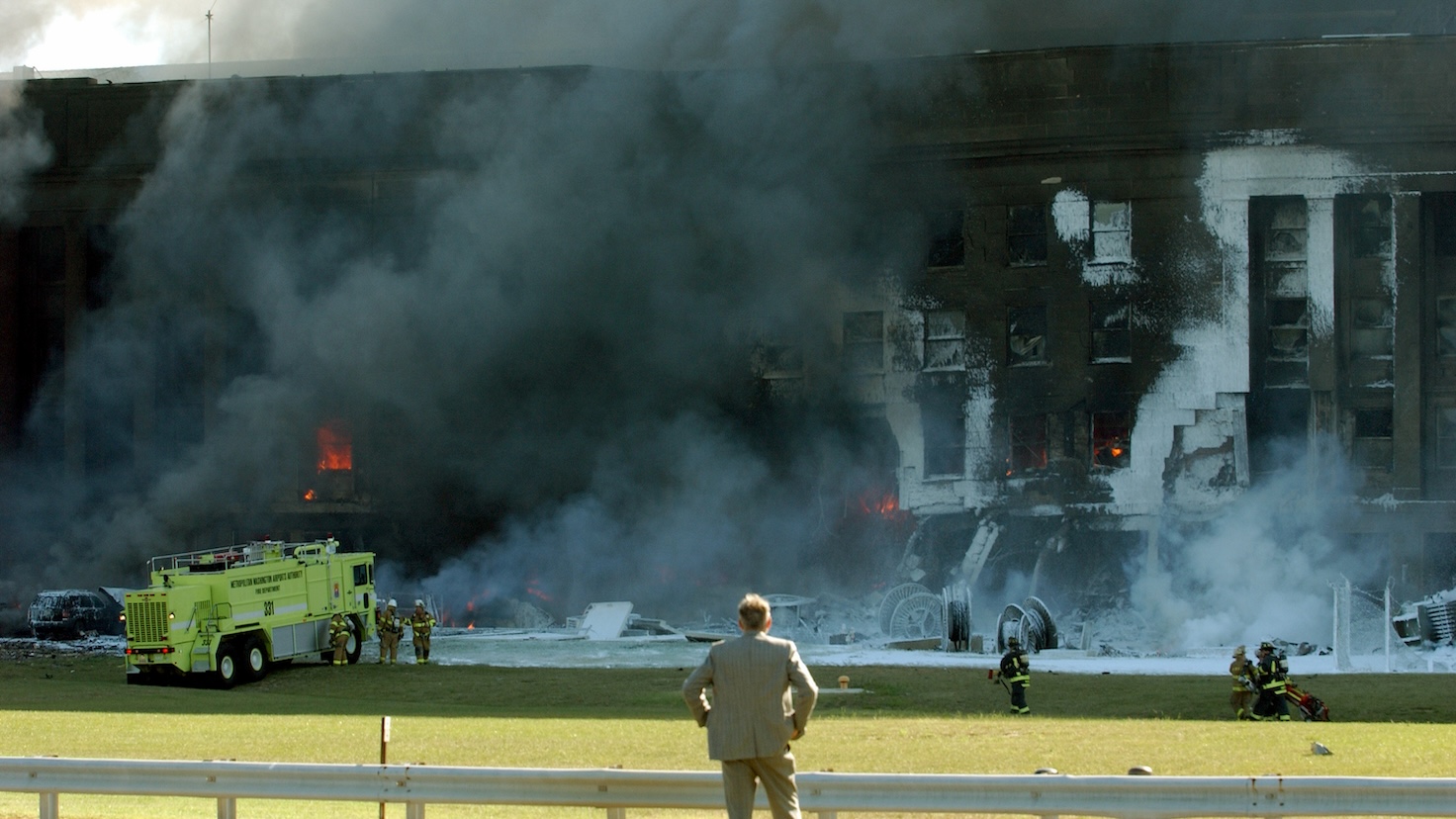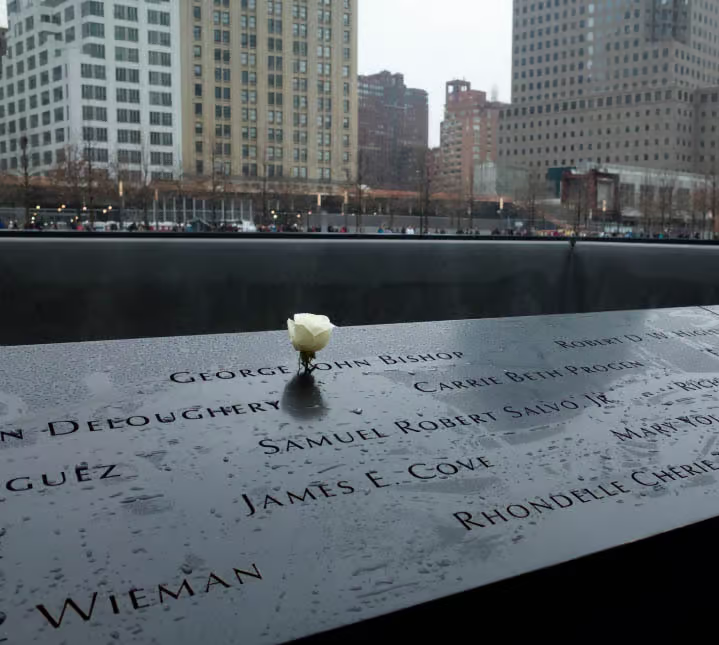Editor’s Note: Response papers were accepted through February 27, 2024. One response paper, which can be read here, has since been published.
Introduction
We envision this to be the first of a series of papers that discuss the best evidence showing that Flight AA77, a Boeing 757 aircraft, departed Dulles Airport and impacted the west face of the Pentagon. The purpose of this initial paper is to provide the observational details that establish the preliminary conclusion that the Pentagon was impacted by a large airplane consistent with a Boeing 757. The evidence is inconsistent with theories that the damage was due to fire, explosives, or impact by a small plane or missile.
Scope of the Damage to the Pentagon Wall
The opening in the Pentagon’s outer wall extends from column 8 to 18. The columns are 10 ft apart, so overall the opening is approximately 100 ft. The 100 ft width of the opening rules out a small plane or a missile. Furthermore, a missile would be expected to punch a small hole then explode, producing focused blast damage centered at the point of detonation. No evidence for this kind of damage is found.
Left Side of Opening
Within the open region, Column 9AA survived, largely stripped of its concrete and bowed inward. This indicates a heavy impact from the outside, but falls short of complete column failure.
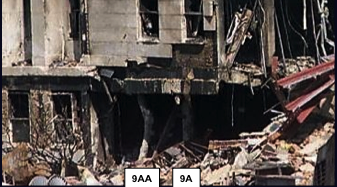
Just to the right of Column 9AA is a section of 8-inch steel tubing, attached top-and-bottom to the floor slabs, with several steel plates (“fingers”) that originally pointed outward used to hold the blast-resistant windows that were installed during the Pentagon renovation. The fingers, bolted to the window frame, were rotated through a large angle, as the window was pushed inward, twisting the steel tubing.
A bowed column requires an impact by something with sufficient mass and energy to produce the observed damage but insufficient to break it. The direction of twist of the steel tubing is consistent with the left wing impacting the window and twisting the tubing as the wing is dragged into the Pentagon by the air frame.
Right Side of Opening
To the right of Column 18, on the exterior of the building, there is surface damage that extends to Column 20.
The strength of the second-floor slab, hit edge-on by the wing, explains why Column 18 was not destroyed. The damage continues along a sloped line through Column 19 and 20. Column 19 is hit just above the slab and Column 20 sustained minor damage a little higher, in line with the other two impact points. This external surface damage, with inward displacement, is a clear sign of impact. It could not have been caused by internal explosions. We propose that the damage was caused by the outer end of the right wing of a large plane which hit the wall and then was dragged into the building around Column 18.
Damage at the Center of Impact
The two wall panels on the second floor centered on Column 14 are missing. The width of the opening is 20 ft minus the half-widths of the adjacent columns. The first questioning of the official narrative of the Pentagon strike was the book, 9/11: The Big Lie (L’Effroyable imposture), by Thierry Meyssan which presented this second floor opening as the full extent of the hole in the Pentagon wall, concluding that the hole was too small for a large plane.
That misconception has survived for decades and for many people it constitutes proof that no plane hit the Pentagon.
However, the same photographer, a few frames later, presumably on the same roll of film, took two other photos that show large portions of the first-floor damage, but Meyssan did not show these photographs. That omission is the basis of the long-standing meme in the 9/11 Truth Movement that “the hole was too small.”
The nose of the plane impacted the ground floor near Column 14. The fuselage does not quite fit into the ground floor, causing it to overlap into the second floor. This impact severely damaged the second-floor slab at this point.
Fire can be seen where the second-floor slab should be, near Column 14, …
and the second-floor section of Column 14 (shown in Figure 6) is badly damaged, detached at the bottom, and dangling by its rebar.
Other Obstructions
Just outside the Pentagon wall, the incoming plane impacted a diesel generator trailer, surrounded by a chain link fence, a concrete retaining wall, and a tree.
The Tree
A large tree was present in front of Column 16. It is visible in prior photography and the shattered stump is visible in the rubble. The height of the stump is consistent with the height of the right wing spar.
The direction of motion of the plane, coming in at a 52° angle, would tend to throw the tree northward and into the Pentagon wall. The tree could be the cause of much, if not most, of the second-floor damage near Column 14.

The tree was thrown base-first and landed northward along the Pentagon wall. Tree branches litter the lawn.
Interestingly, to land as it did, the trunk would have to have torn through the fuselage of the plane. One piece of direct evidence that this actually happened is that a sheet of aluminum, found to the north of the plane’s path, can be identified as coming from the right side of the fuselage. Most of the fuselage went directly into the building. The fact that this piece landed to the north on the lawn is evidence that something tore it from the plane and threw it northward. A section of the overhead luggage rack (not shown) was also found on the lawn.
Between Column rows 9 and 18, all but three of the first-floor columns are missing entirely. Columns 15, 16, and 17 are still present but severed at the base and hanging by their rebar. The presence of the tree in front of column 16 may have helped shield the blow to these columns.
Retaining Wall
A notch in a low concrete retaining wall locates the left engine of the incoming plane. The left engine appears to have dipped to just above ground level at that point.
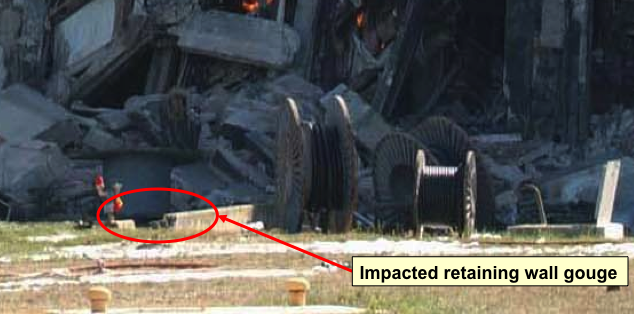
Generator Trailer
The damage to a massive generator trailer locates the right engine. Note also that the chain link fence that surrounded the generator trailer is torn away in the vicinity of the damage to the trailer, but not elsewhere. The selective tearing away of the chain link fence is evidence for impact rather than explosions or fire, as some have proposed.
The generator trailer was rotated toward the building, which is a clear indication of a heavy impact. This could not have been accomplished with an explosion. The distance from the retaining wall to the generator trailer damage, measured perpendicular to the flight path, is 42 ft, which is the spacing of the engines on a Boeing 757. The right engine would have hit the generator trailer first. This would have caused the plane to roll leftward, bringing the left engine into contact with the retaining wall. It would also apply a retarding force to the right side of the plane causing a clockwise rotation about a vertical axis which would rotate the tail northward.
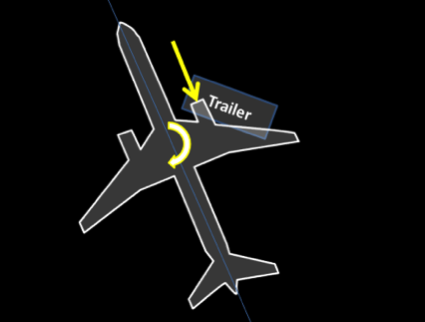
This would account for the missing damage to the building caused by the tail in the vicinity of Column 14. However, if we look at the second-floor slab in the vicinity of column 12 (a northward displacement of about 20 feet) we can see that the bricks and concrete beam under the second-floor windows are missing.
The left wing of the plane was parallel with the ground, so the entire left wing would have passed under the second-floor slab. This would leave the tail as the only part of the plane that would reach the second-floor slab in this vicinity. We can conclude that the tail must have been dragged into the first floor, pivoting on the second-floor slab in the vicinity of Column 12.
Conclusion
The details of the damage to the Pentagon Wall are evidence of large plane impact. Explosives, impact by a small plane, or impact and explosion of a missile cannot account for the damage. Flyover implies no contact between the plane and the Pentagon, so the implied claim would be that all the evidence was faked. However, claims of fakery must be proved. How, exactly, could each item we have detailed have been faked real-time? Given the abundance of consistent evidence for large plane impact, the “fake evidence” claim is not credible.
Note: Most of the material for this paper is based on Wayne Coste’s research archived at https://911speakout.org/wayne-coste/.

